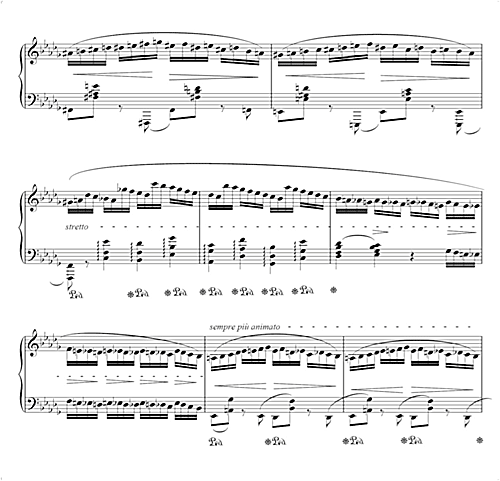The Secret Life of
Musical Notation: Defying Interpretive
Traditions
- Amadeus Press
From Chapter Five - "...of
Stretti" (p. 181)
Rather accidentally,
the subject of this chapter took
shape as I was comparing pedal
markings in editions of Chopin’s Preludes, Op. 28.
Open before me was the third page
of the sixteenth Prelude with its
perilous runs, when for the first
time I noticed a startling anomaly:
a four-measure section marked stretto precedes the sempre
piú animato that leads to the inexorable ending.
It is conventionally accepted that
an increase in speed be applied at
the sight of both signs, and that
stretto has a more circumscribed
intent; and though some performers
claim that stretto should prescribe
a purely expressive connotation – passion,
agitation, rage – these are
attributes that, ultimately, might
incite an acceleration and lead to
a similar, undifferentiated outcome.
As I eventually noticed, this curious
instance is not isolated in the works
of Chopin. I had grown accustomed
to his sometimes idiosyncratic instructions,
yet I thought the idea peculiar that
a composer for whom writing was an
open-ended process that involved
constant revision would have blatantly
overlooked a set of conspicuous redundancies
in regard to tempo. Here is the passage
in question:

Example 5.1 - F.
Chopin: Prelude in B-flat Minor,
Op. 28, no. 16, mm. 28-35
[...] I wondered whether I should
have temporarily broadened the purpose
of stretto or sempre
piú animato in the prelude by imagining that
one marking or the other might refer
to something other than an agogic
coordinate. I began my investigation
when I stumbled upon a letter that
Felix Mendelssohn-Bartholdy wrote
to Robert Schumann on January 10,
1835 – not long before Chopin
wrote the Prelude in B-flat Minor.
Mendelssohn expressed his dissatisfaction
about a performance of his Overture
The Hebrides, which Schumann had
described unfavorably:
It
surprises me much to hear of my
Overture in b minor being taken
faster at the end than at the beginning.
I suppose you mean after the "animato"?
If so, I shall certainly adopt Sebastian
Bach’s practice, who hardly
ever marked a piano or forte on his
music. I thought a "piú stretto" would
hardly do well, as I referred rather
to an increase of spirit, which
I did not know how to indicate
except by animato.¹
I
sensed that Mendelssohn’s
response to the misattribution of
the term animato was not to be taken
lightly. It supports the assertion
that certain markings had begun to
lose their intended connotation – to
such extent that the composer, perhaps
facetiously, was contemplating to
return to a complete absence of interpretive
directions in the score. Markings
that had been chosen for their descriptive
nature were becoming the subject
of ambiguous interpretation. As symbols
were still proliferating and composers
were still wavering about their use,
a consensus on their standardized
meaning would not emerge for decades.
The letter provided me with precious
information: for Mendelssohn, the
marking stretto conveyed an increase
in speed, while animato indicated
a heightened excitement in the musical
material that pertains more to character
than agogics. Was the sempre
piú animato in Chopin’s B-flat Minor Prelude
also intended to evoke an increase
of spirit? And if that had been the
case, should we assume that Chopin
meant for stretto to indicate a temporary
acceleration, and that what ensues
should return to the original speed?
Or should the extensive coda be performed
at a faster pace as a result of that
acceleration?

Join The Secret
Life of Musical Notation on
Facebook! 
|

From
Chapter Two - "...of Sforzandi" (p.
70)
[...]
Working with one of my students on
the middle movement of Haydn’s
Sonata in E-flat Major Hob. XVI/49
brought back memories...


From
Chapter Three - "...of Rinforzandi" (p.
103)
When asked
to describe the role of a rinforzando
that has been placed at the end
of a crescendo whose destination
is an fff, quite a few musicians...


From
Chapter Three - "...of Rinforzandi" (p.
115)
[...]
Mozart did introduce rallentando,
and the earliest traceable examples
emerge in 1785 in pieces such as
the Fantasie in c minor, K. 475 and...


From
Chapter Five - "...of Stretti" (p.
181)
Rather accidentally,
the subject of this chapter took
shape as I was comparing pedal markings...

|

